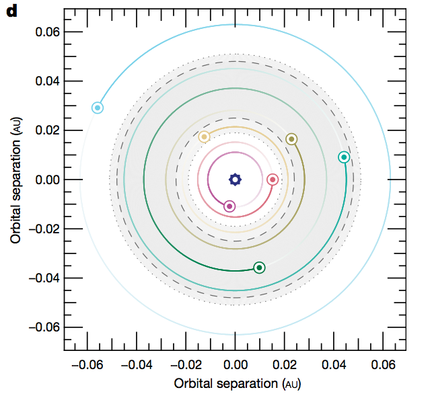Seven planets have been found around a dwarf red star
Through ten telescopes, and thanks to the collaboration of a large international team, seven Earth-like planets have been found around a red dwarf cold at 40 light-years. The research, published in the journal Nature, has been socialized by NASA through a press conference.
In fact, they have used data such as NASA's Hubble and Spitzer space telescope, whose observations have been key to knowing the parameters of the seven planets. Moreover, the seventh planet has only been detected by Spitzer, in a single transsitu. Therefore, they are still pending to confirm detection with other tools.
The project, led by Michael Gillon, an astronomer at the University of Liège, looks for exoplanets through two 60 cm telescopes. One is in Chile and the other in Morocco. And all of them, along with other telescopes, have obtained their results.
The observed star, the cold red dwarf TRAPPIST-1, already knew it and last year reported the existence of planets. Then three were detected, one of them supposedly in the habitable area. Now they have seen that there are four others, which are precisely those that are in habitable area.
For their detection the transposition method has been used and they have been able to calculate not only the measurement but also their mass from the TTV (Transit Timing Variations) technique. Therefore, unlike the planet Proxima b that surrounds our nearest star, they can now say that they are similar to Earth, not only in measure, but also in mass.
To what extent are they habitable?
Because the orbiting star is much smaller than the Sun and cooler (it contains only 8% of the mass of our Sun), the habitable area is much closer to the Earth in this star. And there are the planets, very close to the star. Thus, its orbits range between 1.5 and 20 days.
Considering the distance between the Sun and the planets, the planets d, e, f, and g can be habitable, as they would have the possibility of having liquid water. And that is the criterion that is considered habitable.
However, they do not know whether red dwarfs contain magnetic fields or atmospheres that can be protected from X-rays and emitting particles. Analyzing the density of planets seems to have few metals and many volatile compounds, so they may have atmosphere, but it is the only thing they know for now. In addition, it may always show the same face to your sun, which does not help create and develop life.
However, their way of researching atmospheres has made them an extraordinary laboratory to investigate other worlds and seek extraterrestrial life. And surely there will be more discoveries like this, because now they have focused the search for exoplanets towards dwarf red stars, which are the ones that have the most chances of having planets like Earth. And they are also the most abundant stars in the Universe.







